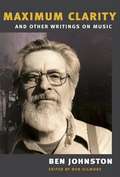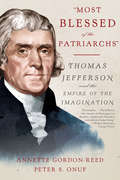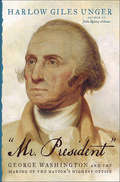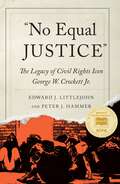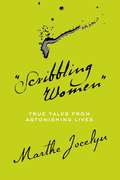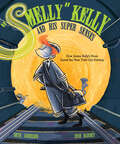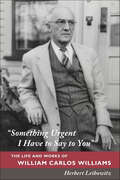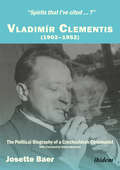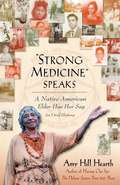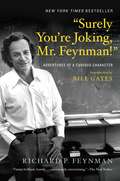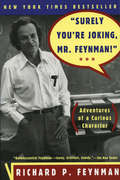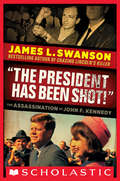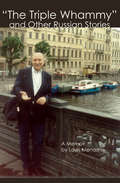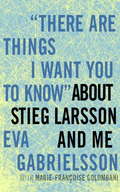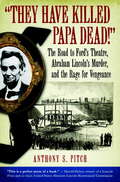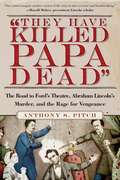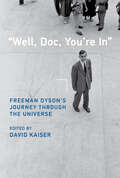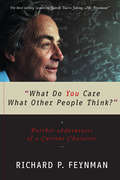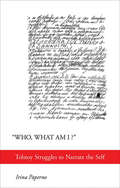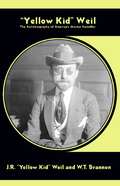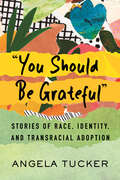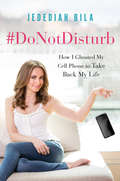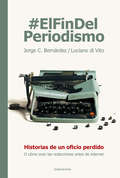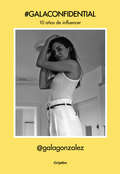- Table View
- List View
"MAXIMUM CLARITY" AND OTHER WRITINGS ON MUSIC
by Ben Gilmore Ben JohnstonDescribed by New York Times critic John Rockwell as "one of the best non-famous composers this country has to offer," Ben Johnston reconceives familiar idioms--ranging from jazz to Southern hymns--using just intonation. Johnston studied with Darius Milhaud, Harry Partch, and John Cage, and is best known for his String Quartet No. 4, a complex series of variations on Amazing Grace. This volume reveals he is also a truly literate composer, who writes and speaks about music with eloquence and charm. "Maximum Clarity" and Other Writings on Music spans forty years and brings together forty-one of Johnston's most important writings, including many rare and several previously unpublished selections. They include position papers, theoretical treatises, program notes, historical reflections, lectures, excerpts from interviews, and letters, and they cover a broad spectrum of concerns--from the technical exegesis of microtonality to the personal and the broadly humanistic. The volume concludes with a discography of all commercially available recordings of Johnston's music.
"Most Blessed of the Patriarchs": Thomas Jefferson and the Empire of the Imagination
by Annette Gordon-Reed Peter S. OnufA groundbreaking work of history that explicates Thomas Jefferson's vision of himself, the American Revolution, Christianity, slavery, and race. Thomas Jefferson is often portrayed as a hopelessly enigmatic figure--a riddle--a man so riven with contradictions that he is almost impossible to know. Lauded as the most articulate voice of American freedom and equality, even as he held people--including his own family--in bondage, Jefferson is variably described as a hypocrite, an atheist, or a simple-minded proponent of limited government who expected all Americans to be farmers forever. Now, Annette Gordon-Reed teams up with America's leading Jefferson scholar, Peter S. Onuf, to present an absorbing and revealing character study that dispels the many clichés that have accrued over the years about our third president. Challenging the widely prevalent belief that Jefferson remains so opaque as to be unknowable, the authors--through their careful analysis, painstaking research, and vivid prose--create a portrait of Jefferson, as he might have painted himself, one "comprised of equal parts sun and shadow" (Jane Kamensky). Tracing Jefferson's philosophical development from youth to old age, the authors explore what they call the "empire" of Jefferson's imagination--an expansive state of mind born of his origins in a slave society, his intellectual influences, and the vaulting ambition that propelled him into public life as a modern avatar of the Enlightenment who, at the same time, likened himself to a figure of old--"the most blessed of the patriarchs." Indeed, Jefferson saw himself as a "patriarch," not just to his country and mountain-like home at Monticello but also to his family, the white half that he loved so publicly, as well as to the black side that he claimed to love, a contradiction of extraordinary historical magnitude. Divided into three sections, "Most Blessed of the Patriarchs" reveals a striking personal dimension to his life. Part I, "Patriarch," explores Jeffersons's origins in Virgina; Part II, " 'Traveller,' " covers his five-year sojourn to Paris; and Part III, "Enthusiast," delves insightfully into the Virginian's views on Christianity, slavery, and race. We see not just his ideas and vision of America but come to know him in an almost familial way, such as through the importance of music in his life. "Most Blessed of the Patriarchs" fundamentally challenges much of what we've come to accept about Jefferson, neither hypocrite nor saint, atheist nor fundamentalist. Gordon-Reed and Onuf, through a close reading of Jefferson's own words, reintroduce us all to our most influential founding father: a man more gifted than most, but complicated in just the ways we all are.
"Mr. President": George Washington and the Making of the Nation's Highest Office
by Harlow Giles UngerAlthough the framers gave the president little authority, George Washington knew whatever he did would set precedents for generations of future leaders. To ensure their ability to defend the nation, he simply ignored the Constitution when he thought it necessary. In a revealing new look at the birth of American government, #147;Mr. President” describes Washington’s presidency in a time of continual crisis, as rebellion and attacks by foreign enemies threatened to destroy this new nation. Constantly weighing preservation of the Union against preservation of individual liberties and states’ rights, Washington assumed more power with each crisis. In a series of brilliant but unconstitutional maneuvers he forced Congress to cede control of the four pillars of executive power: war, finance, foreign affairs, and law enforcement. Drawing on rare documents and letters, Unger shows how Washington combined political cunning and sheer genius to seize ever-widening powers, impose law and order while ensuring individual freedom, and shape the office of President of the United States.
"No Equal Justice": The Legacy of Civil Rights Icon George W. Crockett Jr. (African American Life Series)
by Peter J. Hammer Edward J. Littlejohn"There is no equal justice for Black people today; there never has been. To our everlasting shame, the quality of justice in America has always been and is now directly related to the color of one’s skin as well as to the size of one’s pocketbook." This quote comes from George W. Crockett Jr.’s essay, "A Black Judge Speaks" (Judicature, 1970). The stories of Black lawyers and judges are rarely told. By sharing Crockett’s life of principled courage, "No Equal Justice" breaks this silence. The book begins by tracing the Crockett family history from slavery to George’s admission into the University of Michigan Law School. He became one of the most senior Black lawyers in President Franklin Roosevelt’s New Deal administration. Later, he played a central role fighting discrimination in the United Auto Workers union. In 1949, he became the only Black lawyer, in a team of five attorneys, defending the constitutional rights of the leaders of the U.S. Communist Party in United States v. Dennis, the longest and most dramatic political trial in American history. At the close of the case, Crockett and his defense colleagues were summarily sentenced to prison for zealously representing their clients. He headed the National Lawyers Guild office in Jackson, Mississippi, during 1964’s Freedom Summer. In 1966, he was elected to Detroit’s Recorder’s Court—the court hearing all criminal cases in the city. For the first time, Detroit had a courtroom where Black litigants knew they would be treated fairly. In 1969, the New Bethel Church Incident was Crockett’s most famous case. He held court proceeding in the police station itself, freeing members of a Black nationalist group who had been illegally arrested. In 1980, he was elected to the United States Congress where he spent a decade fighting President Reagan’s agenda, as well as working to end Apartheid in South Africa and championing the cause to free Nelson Mandela. Crockett spent his life fighting racism and defending the constitutional rights of the oppressed. This book introduces him to a new generation of readers, historians, and social justice activists.
"Sail" leading to distant goals: A brief history of the most famous school newspaper of Novorossiysk
by Sergey KonyashinThe documentary-memoir story "Sail leading to distant goals" is devoted to the history of the appearance, formation and development of the Novorossiysk school newspaper "Parus (Sail)", published from 1992 to 2015, as well as the enormous influence that this print edition had on the children's press in the city of Novorossiysk and far beyond. The book was written by Sergey Konyashin, a former cadet of "Parus", twice the "Young Journalist of the Year" in Novorossiysk (1999 and 2000), whose creative path into the great Russian journalism and diplomacy began from the pages of this — now largely legendary — children's print edition. Sergey Konyashin's memoirs will be of interest primarily to those who seek to learn more about the history of the Novorossiysk school press, its place in the development of the city's additional education system, as well as in the fate of some gifted Novorossiysk children.
"Scribbling Women": True Tales from Astonishing Lives
by Marthe JocelynIn 1855, Nathaniel Hawthorne wrote to his publisher, complaining about the irritating fad of "scribbling women." Whether they were written by professionals, by women who simply wanted to connect with others, or by those who wanted to leave a record of their lives, those "scribbles" are fascinating, informative, and instructive.Margaret Catchpole was a transported prisoner whose eleven letters provide the earliest record of white settlement in Australia. Writing hundreds of years later, Aboriginal writer Doris Pilkington-Garimara wrote a novel about another kind of exile in Australia. Young Isabella Beeton, one of twenty-one children and herself the mother of four, managed to write a groundbreaking cookbook before she died at the age of twenty-eight. World traveler and journalist Nelly Bly used her writing to expose terrible injustices. Sei Shonagan has left us poetry and journal entries that provide a vivid look at the pampered life and intrigues in Japan's imperial court. Ada Blackjack, sole survivor of a disastrous scientific expedition in the Arctic, fought isolation and fear with her precious Eversharp pencil. Dr. Dang Thuy Tram's diary, written in a field hospital in the steaming North Vietnamese jungle while American bombs fell, is a heartbreaking record of fear and hope.Many of the women in "Scribbling Women" had eventful lives. They became friends with cannibals, delivered babies, stole horses, and sailed on whaling ships. Others lived quietly, close to home. But each of them has illuminated the world through her words.A note from the author: OOPS! On page 197, the credit for the Portrait of Harriet Jacobs on page 43 should read: courtesy of Library of Congress, not Jean Fagan Yellin. On page 197, the credit for the portrait of Isabella Beeton on page 61 should read: National Portrait Gallery, London. On page 198, the credit for page 147 should be Dang Kim Tram, not Kim Tram Dang. We are very sorry about the mix-up in the Photo Credits, they will be updated on any new editions or reprints.From the Hardcover edition.
"Smelly" Kelly and His Super Senses: How James Kelly's Nose Saved the New York City Subway
by Beth AndersonNSTA Best STEM Book James "Smelly" Kelly used his super-senses and intelligence to make sure that the New York City subway in the 1930s ran safely throughout his lifetime and beyond.James Kelly smelled EVERYTHING: rats in the shed; circus elephants a mile away; tomorrow's rain. His sense of smell was EXTRAORDINARY. But what good was a powerful nose? How could his super-sniffer make him special? In the New York City subway, James found his calling--and earned the nickname "Smelly" Kelly. Armed with his super-sniffer and the tools he invented, he tracked down leaks from the dangerous to the disgusting, from the comical to the bizarre. Then, he sprang into action to prevent cave-ins and explosions in the tunnels beneath the city. Smelly Kelly not only hunted leaks but also saved lives--and he discovered the truly extraordinary power inside him. Beth Anderson's fast-paced text and Jenn Harney's comical illustrations bring to life this everyday superhero.
"Something Urgent I Have to Say to You": The Life and Works of William Carlos Williams
by Herbert LeibowitzHerbert Leibowitz's "Something Urgent I Have to Say to You" provides a new perspective on the life and poetry of the doctor poet William Carlos Williams, a key American writer who led one of the more eventful literary lives of the twentieth century. Friends with most of the contemporary innovators of his era-Ezra Pound, James Joyce, Ford Madox Ford, and Louis Zukofsky, among others-Williams made a radical break with the modernist tradition by seeking to invent an entirely fresh and singularly American poetic, whose subject matter derived from the everyday lives of the citizens and poor immigrant communities of northern New Jersey. His poems mirrored both the conflicts of his own life and the convulsions that afflicted American society-two world wars, a rampaging flu pan-demic, and the Great Depression.Leibowitz's biography offers a compelling description of the work that inspired a seminal, controversial movement in American verse, as well as a rounded portrait of a complicated man: pugnacious and kindly, ambitious and insecure, self-critical and imaginative. "Something Urgent I Have to Say to You" is both a long-overdue assessment of a major American writer and an entertaining examination of the twentieth-century avant-garde art and poetry scene, with its memorable cast of eccentric pioneers, including Marcel Duchamp, Man Ray, Marianne Moore, and Gertrude Stein.
"Spirits that I've cited...?" Vladimír Clementis (1902–1952): The Political Biography of a Czechoslovak Communist
by Josette BaerBaer's biography of the former Czechoslovak foreign minister Vladimír Clementis (1902–1952) is the first historical study on the Communist politician who was executed with Rudolf Slánský and other top Communist Party members after the show trial of 1952. Born in Tisovec, Central Slovakia, Clementis studied law at Charles University in Prague in the 1920s and had his own law firm in Bratislava in the 1930s. After the Munich Agreement of 1938, he went into exile to France and Great Britain, where he worked at the Czechoslovak broadcast at the BBC for the exile government of Edvard Beneš. After the Second World War, Clementis' political career at the Czechoslovak Foreign Ministry blossomed. In 1945, he became Assistant Secretary of State under Foreign Minister Jan Masaryk. After Masaryk's mysterious death in 1948, Clementis was appointed foreign minister. This biography offers an unprecedented insight into the mind of a Slovak leftist intellectual of the interwar generation who died at the command of the comrade he had admired since his youth: Generalissimus Stalin.
"Strong Medicine" Speaks: A Native American Elder Has Her Say
by Amy Hill Hearth"Strong Medicine" Gould is an eighty-five-year-old Elder in her Lenni-Lenape tribe and community. Taking turns with the author as the two women alternate voices throughout this moving book, Strong Medicine tells of her ancestry.
"Surely You're Joking, Mr. Feynman!": Adventures of a Curious Character
by Bill Gates Ralph Leighton Richard P. FeynmanOne of the most famous science books of our time, the phenomenal national bestseller that "buzzes with energy, anecdote and life. It almost makes you want to become a physicist" (Science Digest). Richard P. Feynman, winner of the Nobel Prize in physics, thrived on outrageous adventures. In this lively work that “can shatter the stereotype of the stuffy scientist” (Detroit Free Press), Feynman recounts his experiences trading ideas on atomic physics with Einstein and cracking the uncrackable safes guarding the most deeply held nuclear secrets—and much more of an eyebrow-raising nature. In his stories, Feynman’s life shines through in all its eccentric glory—a combustible mixture of high intelligence, unlimited curiosity, and raging chutzpah. Included for this edition is a new introduction by Bill Gates.
"Surely You're Joking, Mr. Feynman!": Adventures of a Curious Character
by Ralph Leighton Richard P. FeynmanA New York Times bestseller--the outrageous exploits of one of this century's greatest scientific minds and a legendary American original. Richard Feynman, winner of the Nobel Prize in physics, thrived on outrageous adventures. Here he recounts in his inimitable voice his experience trading ideas on atomic physics with Einstein and Bohr and ideas on gambling with Nick the Greek; cracking the uncrackable safes guarding the most deeply held nuclear secrets; accompanying a ballet on his bongo drums; painting a naked female toreador. In short, here is Feynman's life in all its eccentric--a combustible mixture of high intelligence, unlimited curiosity, and raging chutzpah.
"The President Has Been Shot!": The Assassination Of John F. Kennedy
by James L. SwansonA breathtaking and dramatic account of the JFK assassination by the NEW YORK TIMES bestselling author of CHASING LINCOLN'S KILLER!In his new young-adult book on the Kennedy assassination, James Swanson will transport readers back to one of the most shocking, sad, and terrifying events in American history. As he did in his bestselling Scholastic YA book, CHASING LINCOLN'S KILLER, Swanson will deploy his signature "you are there" style -- a riveting, ticking-clock pace, with an unprecedented eye for dramatic details and impeccable historical accuracy -- to tell the story of the JFK assassination as it has never been told before.The book will be illustrated with archival photos, and will have diagrams, source notes, bibliography, places to visit, and an index.
"The Triple Whammy" and Other Russian Stories: A Memoir
by Luis MenasheAn American historian, film specialist, and documentary filmmaker shares candid stories of his life in Russia during and after the Cold War. A captivating lifetime of personal and professional experiences by an American historian, film specialist, and documentary filmmaker in the Soviet Union and post-Soviet Russia. The author&’s experiences as a radical in the turbulent 1960s, and his eventual disenchantment offer some precedents and perspectives to all those on the Left, Center, or Right interested in the fluctuations of American politics. The vivid log of hopes and disillusions is related in a candid, non-academic style, and set against a panorama of history and politics in the late twentieth century.&“A self-described scholar-activist, Menashe weaves together political, intellectual, and cultural currents of leftist life, and draws a vivid picture of people and places, life-changing adventures, the intellectual and political challenges of graduate school during the Cold War, encounters with key Russian literary and political figures, and much more. Then comes the crash, the Soviet Union&’s end. As in all failed love affairs, Menashe retains some sweet memories. The reader will taste them long after reading the memoir.&” —Carole Turbin, Professor Emerita, History and Sociology, SUNY/Empire State College
"There Are Things I Want You to Know" about Stieg Larsson and Me
by Linda Coverdale Marie-Francoise Colombani Eva GabrielssonHere is the real inside story--not the one about the Stieg Larsson phenomenon, but rather the love story of a man and a woman whose lives came to be guided by politics and love, coffee and activism, writing and friendship. Only one person in the world knows that story well enough to tell it with authority. Her name is Eva Gabrielsson. Eva Gabrielsson and Stieg Larsson shared everything, starting when they were both eighteen until his untimely death thirty-two years later at the age of fifty. In "There Are Things I Want You to Know" about Stieg Larsson and Me, Eva Gabrielsson accepts the daunting challenge of telling the story of their shared life steeped in love and sharpened in the struggle for justice and human rights. She chooses to tell it in short, spare, lyrical chapters, like snapshots, regaling Larsson's readers with the inside account of how he wrote, why he wrote, who the sources were for Lisbeth and his other characters--graciously answering Stieg Larsson's readers' most pressing questions--and at the same time telling us the things we didn't know we wanted to know--about love and loss, death, betrayal, and the mistreatment of women.
"They Have Killed Papa Dead!" The Road to Ford's Theatre, Abraham Lincoln's Murder, and the Rage for Vengeance
by Anthony S. PitchThe assassination of Abraham Lincoln is a central drama of the American experience. Its impact is felt to this day, and the basic story is known to all. Anthony Pitch's thrilling account of the Lincoln conspiracy and its aftermath transcends the mere facts of that awful night during which dashing actor John Wilkes Booth shot Lincoln in the head and would-be assassin Lewis Payne butchered Secretary of State William Seward in the bed of his own home. "They Have Killed Papa Dead!" transports the reader to one of the most breathtaking moments in history, and reveals much that is new about the stories, passions, and times of those who shaped this great tragedy. Virtually every word of Anthony Pitch's account is based on primary source material: new quotes from previously unpublished diaries, letters and journals - authentic contemporary voices writing with freshness and clarity as eyewitnesses or intimate participants - new images, a new vision and understanding of one of America's defining moments. With an unwavering fidelity to historical accuracy, Pitch provides new confirmation of threats against the president-elect's life as he traveled to Washington by train for his first inauguration, and a vivid personal account of John Wilkes Booth being physically restrained from approaching Lincoln at his second inauguration. Perhaps most chillingly, new details come to light about conditions in the special prison where the civilian conspirators accused of participating in the Lincoln assassination endured tortuous conditions in extreme isolation and deprivation, hooded and shackled, before and even during their military trial. Pitch masterfully synthesizes the findings of his prodigious research into a tight, gripping narrative that adds important new insights to our national story.
"They Have Killed Papa Dead!": The Road to Ford's Theatre, Abraham Lincoln's Murder, and the Rage for Vengeance
by Anthony S. PitchThe assassination of Abraham Lincoln is a central drama of the American experience. Its impact is felt to this day, and the basic story is known to all. Anthony Pitch's thrilling account of the Lincoln conspiracy and its aftermath transcends the mere facts of that awful night during which dashing actor John Wilkes Booth shot Lincoln in the head and would-be assassin Lewis Payne butchered Secretary of State William Seward in the bed of his own home. <p><p> "They Have Killed Papa Dead!" transports the reader to one of the most breathtaking moments in history, and reveals much about the stories, passions, and times of those who shaped this great tragedy. Virtually every word of Anthony Pitch's account is based on primary source material: quotes from previously unpublished documents, diaries, letters, and journals. With an unwavering fidelity to historical accuracy, Pitch provides confirmation of threats against the president-elect's life as he traveled to Washington by train for his first inauguration, and a vivid personal account of John Wilkes Booth being physically restrained from approaching Lincoln at his second inauguration. <p> Perhaps most chillingly, details come to light about conditions in the special prison where the civilian conspirators accused of participating in the Lincoln assassination endured tortuous conditions in extreme isolation and deprivation, hooded and shackled, before and even during their military trial. Pitch masterfully synthesizes the findings of his prodigious research into a tight, gripping narrative that adds important insights to our national story.
"Well, Doc, You're In": Freeman Dyson’s Journey through the Universe
by Edited by David KaiserThe life and work of Freeman Dyson—renowned scientist, visionary, and iconoclast—and his particular way of thinking about deep questions.Freeman Dyson (1923–2020)—renowned scientist, visionary, and iconoclast—helped invent modern physics. Not bound by disciplinary divisions, he went on to explore foundational topics in mathematics, astrophysics, and the origin of life. General readers were introduced to Dyson&’s roving mind and heterodox approach in his 1979 book Disturbing the Universe, a poignant autobiographical reflection on life and science. &“Well, Doc, You&’re In&” (the title quotes Richard Feynman&’s remark to Dyson at a physics conference) offers a fresh examination of Dyson&’s life and work, exploring his particular way of thinking about deep questions that range from the nature of matter to the ultimate fate of the universe. The chapters—written by leading scientists, historians, and science journalists, including some of Dyson&’s colleagues—trace Dyson&’s formative years, his budding interests and curiosities, and his wide-ranging work across the natural sciences, technology, and public policy. They describe Dyson&’s innovations at the intersection of quantum theory and relativity, his novel nuclear reactor design (and his never-realized idea of a spacecraft powered by nuclear weapons), his years at the Institute for Advanced Study, and his foray into cosmology. In the coda, Dyson&’s daughter Esther reflects on growing up in the Dyson household. &“Well, Doc, You&’re In&” assesses Dyson&’s successes, blind spots, and influence, assembling a portrait of a scientist&’s outsized legacy. ContributorsJeremy Bernstein, Robbert Dijkgraaf, Esther Dyson, George Dyson, Ann Finkbeiner, Amanda Gefter, Ashutosh Jogalekar, David Kaiser, Caleb Scharf, William Thomas
"What Do You Care What Other People Think?": Further Adventures of a Curious Character
by Ralph Leighton Richard P. FeynmanThe New York Times best-selling sequel to "Surely You're Joking, Mr. Feynman!" One of the greatest physicists of the twentieth century, Richard Feynman possessed an unquenchable thirst for adventure and an unparalleled ability to tell the stories of his life. "What Do You Care What Other People Think?" is Feynman's last literary legacy, prepared with his friend and fellow drummer, Ralph Leighton. Among its many tales--some funny, others intensely moving--we meet Feynman's first wife, Arlene, who taught him of love's irreducible mystery as she lay dying in a hospital bed while he worked nearby on the atomic bomb at Los Alamos. We are also given a fascinating narrative of the investigation of the space shuttle Challenger's explosion in 1986, and we relive the moment when Feynman revealed the disaster's cause by an elegant experiment: dropping a ring of rubber into a glass of cold water and pulling it out, misshapen.
"Who, What Am I?": Tolstoy Struggles to Narrate the Self
by Irina Paperno"God only knows how many diverse, captivating impressions and thoughts evoked by these impressions . . . pass in a single day. If it were only possible to render them in such a way that I could easily read myself and that others could read me as I do. . ." Such was the desire of the young Tolstoy. Although he knew that this narrative utopia—turning the totality of his life into a book—would remain unfulfilled, Tolstoy would spend the rest of his life attempting to achieve it. "Who, What Am I?" is an account of Tolstoy's lifelong attempt to find adequate ways to represent the self, to probe its limits and, ultimately, to arrive at an identity not based on the bodily self and its accumulated life experience. This book guides readers through the voluminous, highly personal nonfiction writings that Tolstoy produced from the 1850s until his death in 1910. The variety of these texts is enormous, including diaries, religious tracts, personal confessions, letters, autobiographical fragments, and the meticulous accounts of dreams. For Tolstoy, inherent in the structure of the narrative form was a conception of life that accorded linear temporal order a predominant role, and this implied finitude. He refused to accept that human life stopped with death and that the self was limited to what could be remembered and told. In short, his was a philosophical and religious quest, and he followed in the footsteps of many, from Plato and Augustine to Rousseau and Schopenhauer. In reconstructing Tolstoy's struggles, this book reflects on the problems of self and narrative as well as provides an intellectual and psychological biography of the writer.
"Yellow Kid" Weil
by J. R. Weil Bruno Ruhland W. T. BrannonBilked bankers, grifted gamblers, and swindled spinsters: welcome to the world of confidence men.You'll marvel at the elaborate schemes developed by The Yellow Kid and cry for the marks who lost it all to his ingenuity-$8,000,000 by some estimations. Fixed horse races, bad real-estate deals, even a money-making machine-all were tools of the trade for the Kid and his associates: the Swede, the Butterine Kid, the Harmony Kid, Fats Levine, and others. The Sting (1973), starring Paul Newman and based largely on the story of the Yellow Kid, is entertaining, but is no match for the real deal.
"You Should Be Grateful": Stories of Race, Identity, and Transracial Adoption
by Angela TuckerAn adoption expert and transracial adoptee herself examines the unique perspectives and challenges these adoptees have as they navigate multiple cultures&“Your parents are so amazing for adopting you! You should be grateful that you were adopted.&”Angela Tucker is a Black woman, adopted from foster care by white parents. She has heard this microaggression her entire life, usually from well-intentioned strangers who view her adoptive parents as noble saviors. She is grateful for many aspects of her life, but being transracially adopted involves layers of rejection, loss, and complexity that cannot be summed up so easily.In &“You Should Be Grateful,&” Tucker centers the experiences of adoptees to share deeply personal stories, well-researched history, and engrossing anecdotes from mentorship sessions with adopted youth. These perspectives challenge the fairy-tale narrative of adoption, giving way to a fuller story that explores the impacts of racism, classism, family, love, and belonging.
#DoNotDisturb: How I Ghosted My Cell Phone to Take Back My Life
by Jedediah BilaHave you ever looked at your email, then texts, then Facebook, then Twitter, then email, then Instagram, then Candy Crush, then texts, then Snapchat, then texts again, and now you’ve wasted the time you had set aside for more important things? Jedediah Bila has solved her own Obsessive Compulsive Tech Disorder, and she did it without throwing away her devices.It's time to switch on airplane mode and settle into Jedediah Bila’s #DoNotDisturb: How I Ghosted My Cell Phone to Take Back My Life.In this timely, entertaining and inspiring book, Jedediah Bila chronicles her chaotic, confusing, and all-consuming love-hate relationship with - her cell phone. Stepping back from the whirlwind of texting, social media, and an endless sea of apps, Bila questions how our relationships, character, and sanity have suffered from our deep dive into the digital abyss. Exploring the toll that tech addiction took on her life, Bila reveals her missteps and mistakes, including several upending, life-altering months swirling in an ex-boyfriend’s cell-phone-enabled double life, and how a low-tech millennial later stole her heart.Travel with Jedediah through the embarrassing and catastrophic consequences of Ménage-a-Tech relationships, social media's Perception Deception, and the One-Potato-Chip-Problem of trying to resist Silicon Valley's hypnotic, slot-machine software designed to lure you in. Bila reveals how she navigated away from an unhealthy, oversaturated diet of tech junk food to striking just the right balance with technology to let her unplugged, real-life moments take charge. In #DoNotDisturb, Bila applies her trademark no-nonsense, common-sense, personal responsibility and accountability-centered approach, warning us that if we don’t stop acting like robots, our very humanity is at stake. Through warm anecdotes and cold, hard truths, Bila reveals how she pulled her way out of the tech fog to keep her eyes focused on the life right in front of her. And how you can too.
#ElFinDelPeriodismo: Historias de un oficio perdido o cómo eran las redacciones antes de internet
by Jorge C. Bernárdez Luciano Di VitoA través de entrevistas a doce de los periodistas de mayor trayectoria en el país, los autores reconstruyen un mundo en vías de extinción: el de las redacciones de algunos de los diarios y las revistas más importantes de la Argentina, con experiencias fundamentales de la radio y la televisión. El resultado es un retrato del periodismo de investigación que supimos tener... antes de Twitter y Google. Los autores se preguntan sobre el destino del periodismo en tiempos de Internet, Twitter y un universo nuevo de noticias de acceso y consumo veloces, pero dudosas, y en el que la opinión le gana lugar a la información. Dignos discípulos de una raza de periodistas en vías desaparición, para reconstruir cómo vivieron este oficio las últimas generaciones predigitales -hace tan solo dos, tres, cuatro décadas-, Bernárdez y Di Vito van a las fuentes, en busca del testimonio directo de varios de sus principales, más curtidos e inteligentes protagonistas. En las páginas de El fin del periodismo, recuerdan cómo empezaron, cómo era una redacción cuando aún se podía fumar en interiores, y cómo era investigar una noticia sin Google. Entrevistan a personajes enormes como Ernesto Cherquis Bialo (ex director de El Gráfico, gerente de deportes de Telefe, vocero de AFA, coautor de Yo soy el Diego de la gente, actualmente en Infobae), Jorge Fernández Díaz, Beto Casella, Any Ventura, Gerardo Rozin (actual conductor de Morfi, todos a la mesa), Teresita Ferrari (El Día, Siete Días, La Semana, Para Ti, Cosmopolitan; fue productora de La noticia rebelde y colaboradora de Juan Alberto Badía y Fernando Bravo), Carlos Ulanovsky, Enrique Vázquez (revista Humo®), Fernando Cerolini (Tiempo Argentino, TN, revista Pronto), Rubén Oliva (Edición Plus en Telefé), Cecilia Absatz (Para Ti, Noticias y La Nación; TN), y Fernando González (rector de Tea, ex Radio del Plata, Perfil y Página/30 y autor de La cocina de la noticia).
#GalaConfidential: 10 años de influencer
by Gala GonzálezLos secretos personales, profesionales y de moda de la influencer española más internacional: Gala González. Pocas españolas pueden presumir de haber alcanzado un reconocimiento a nivel mundial. <P><P>Gala González ha conseguido, a fuerza de profesionalidad, tesón y una buena combinación de experimentación y comercialidad a la hora de vestir, convertirse en un icono de estilo más allá de nuestras fronteras y ser la única española en alcanzar el top ten de las mejores influencers del mundo. <P><P>Nació en Galicia y se graduó en diseño por la Universidad de Londres. Fue una de las pioneras en su andadura en el mundo online, cuando en 2005 abrió su primera plataforma, Fotolog. La gran acogida que recibió la animó a crear su propio espacio 2.0 dedicado a la moda, amlul.com, uno de los primeros blogs con proyección internacional. <P>Desde entonces su popularidad como influencer, diseñadora, directora creativa y modelo no ha hecho más que crecer, y además de ser un auténtico referente, puede presumir de haber protagonizado campañas de moda, como las de Loewe y Mango, y haber diseñado colecciones para Tous, Superga y la línea U de Adolfo Domínguez, entre otras. <P>Sin duda, su estilo, real y ecléctico, es su mejor aval. #GalaConfidential recoge más de una década de su trayectoria en una de las profesiones que más han dado que hablar en los últimos años, además de sus experiencias personales como influencer de éxito, que revelan su parte más humana. <P>Este libro también nace con la vocación de ser una guía para todo aquel que quiera aventurarse en la industria de la moda y la comunicación online, o simplemente trate de descubrir el camino que hay que seguir para triunfar fuera y dentro del mundo digital.
